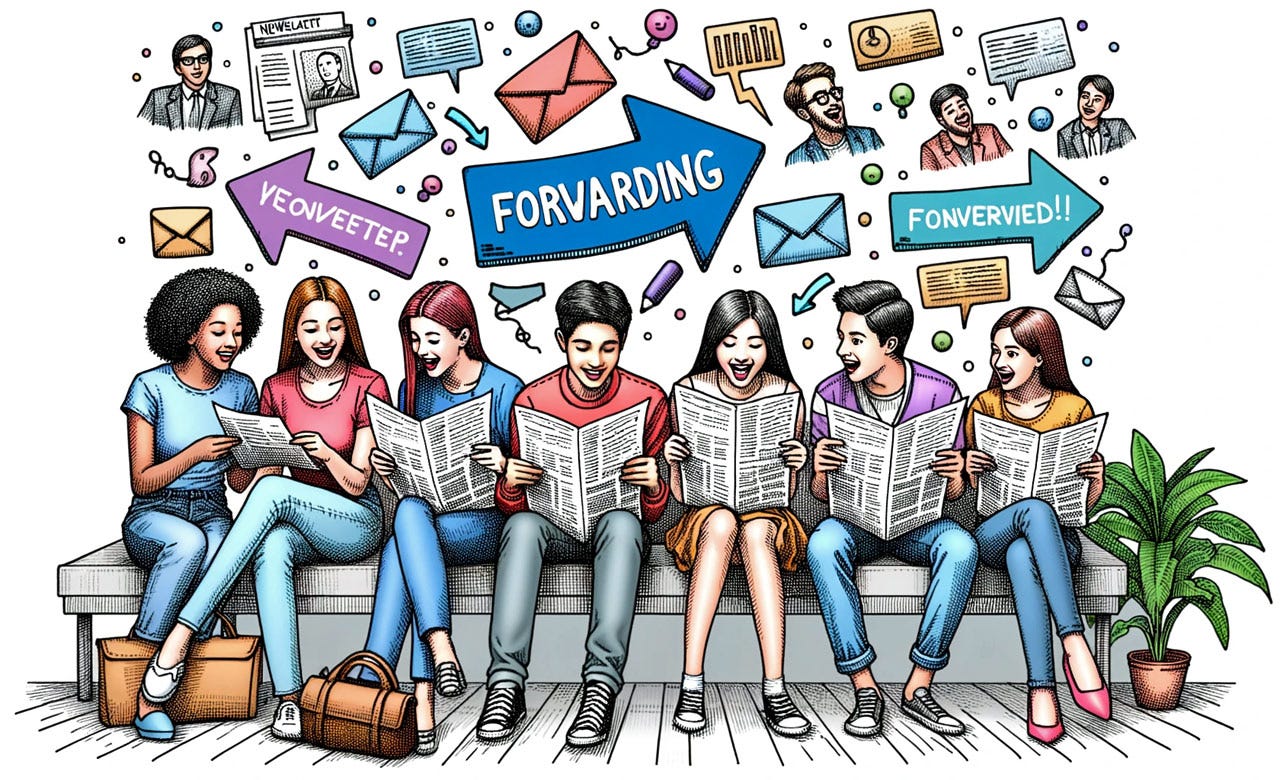Summary: From zero to ten thousand subscribers in half a year. Why are email subscribers the most important success metric, and how does one grow this permission channel to communicate directly with fans?
I recently passed 10,000 subscribers to my new Substack email newsletter, which I started on June 21, 2023. The journey from zero to ten thousand took half a year. Thank you to all subscribers! I write for you.
Celebrating 10,000 subscribers to my email newsletter. (Toast by Dall-E.) A sad story: this image was generated when I asked Dall-E for an image to illustrate reaching 100,000 followers on LinkedIn. Current GenAI is really bad with numbers 😕 but luckily, I could just save the image and use it for my next milestone, featuring one less zero.
Subscriber numbers experience exponential growth if you write a good newsletter. Some percentage of recipients will like any given issue enough that they forward it to a friend or colleague. If you’re lucky (or really good!), they’ll forward your email to an internal mailing list or other larger set of recipients. Some of the people who receive a forwarded email will like it enough to subscribe on their own.
Both of these two conversion rates are fairly small: (a) subscribers who forward, and (b) forwarding recipients who subscribe. Multiply two low ratios, and you get an even smaller ratio. Your goal as a newsletter author is to be good enough to boost both conversion rates and thus get a higher exponent for your exponential growth.
Three important things about exponential growth:
Absolute numbers are abysmally low in the beginning.
Absolute numbers explode later, if you have high conversion rates
Nothing grows forever
As for the last point, after some time, most of your subscribers’ friends have received several forwarded emails from you and have either already subscribed on their own or decided not to subscribe. (Maybe they’re satisfied with getting forwarded newsletters the few times you hit their exact interest, which their friend hopefully knows.)
Midjourney’s version of writing for 10,000 subscribers.
Email vs. Social Media for Influencer Reach
Comparing my 106,000 LinkedIn followers with my 10,000 email newsletter subscribers, there’s no doubt that the newsletter subscribers are much more important, even though they only equate to 10% of the social media followers. Email is true permission marketing, as emphasized by the world’s leading Internet marketing guru, Seth Godin. Empirically, my analytics also show that the newsletter produces about 7 times more article-reads than LinkedIn does. Thus, email is roughly 70 times better than social media on a per-subscriber/follower basis as a channel to reach my audience.
I have deliberately targeted newsletter growth over SEO for my website, UXtigers.com. We’re entering a time when users will be turning to AI rather than search to answer their questions, diminishing the ability to rely on SEO, even for strong content. Social media has long been diluted as a way to reach a serious audience. Email remains the strongest channel despite being the oldest Internet media form.
Users’ inboxes are cluttered, so email only works when you have strong content that subscribers want to read. My open rate is 51%, which is 2.4 times the industry average of 21% (according to Campaign Monitor’s analysis of 100 billion messages in 2021).
Steady Growth Overcomes Small Initial Numbers
If you start your own newsletter, don’t be discouraged by the initial small numbers. In my first week, I only had 149 subscribers. Why would I ever bother writing for a virtual handful of readers? But a week later, I had 333 subscribers. This was still worthless in absolute numbers, but represented 123% more subscribers in a week. A fabulous growth rate, and even though the first few weeks never generalize for the long term, my sustainable growth rate has turned out to be very strong.
The conversion funnel to grow subscribers for an email newsletter has many steps: (1) existing subscribers read, (2) they forward to interested friends and colleagues, and (3) recipients of a forwarded email decide to get their own subscription. A decent conversion rate at each step generates exponential growth. (Image generated with Dall-E.)
The most impressive metric is that my new newsletter has 6 times as many subscribers as my old newsletter from the dot-com bubble era, when comparing subs for the same number of days after newsletter launch (October 1, 1997 for my old Alertbox newsletter and June 21, 2023 for my new newsletter.)
Here’s a nice essay explaining exponential growth, and how it generates superlinear returns. It’s not the case that if you’re x% better, you only get x% more business. You get much more, as growth compounds. Exponential growth scenarios are close to being a winner-takes-all scenario because a bigger growth rate will allow you to eventually dominate anybody who started before you but has a lower growth rate.
I write for my UX friends, not the haters. (I tried to make Dall-E draw a writer who looks like me, but all 8 mature gentlemen it produced had a gray beard, despite my prompts for “no beard” or “cleanshaven”)
Thus, even though 10,000 subscribers are nothing in a world with 3 million UX professionals, I feel good about getting my message out, both now and in the future. I am not sure how many subscribers I’ll get since I know that I have a certain perspective and attitude that many people don’t like. I don’t write for my enemies; I write for my friends. I’d rather have fewer subscribers who accept me for who I am, than more subscribers who require me to water down my message.
Whatever many people there are in the world who like my thinking, that’s my true SAM (serviceable available market), which is more realistic than the 3M TAM (total addressable market). I’m not writing to sell anything, but to help my readers and the users of the world. That’s the beauty of no longer running a business that suppressed my creativity for the last decade: Now, I don’t worry about what customers will buy or offending their delicate sensibilities, only about the truth. The new Jakob is the old Jakob who escaped from the corporate salt mine.
An old Arab proverb says, “The dogs bark, but the caravan moves on.” In this story, I chose to be the camel and ignore the yapping haters in favor of keeping my eyes firmly on the road ahead, serving as an unflinching defender of the world’s users and progress in user experience. (DallE)
Worldwide Reach
I have subscribers in 126 countries and territories. The following pie chart shows the geographic distribution of my subscribers:
When I press “send,” newsletters fly around the world to 126 countries. (Midjourney)
About the Author
Jakob Nielsen, Ph.D., is a usability pioneer with 41 years experience in UX and the Founder of UX Tigers. He founded the discount usability movement for fast and cheap iterative design, including heuristic evaluation and the 10 usability heuristics. He formulated the eponymous Jakob’s Law of the Internet User Experience. Named “the king of usability” by Internet Magazine, “the guru of Web page usability” by The New York Times, and “the next best thing to a true time machine” by USA Today. Previously, Dr. Nielsen was a Sun Microsystems Distinguished Engineer and a Member of Research Staff at Bell Communications Research, the branch of Bell Labs owned by the Regional Bell Operating Companies. He is the author of 8 books, including the best-selling Designing Web Usability: The Practice of Simplicity (published in 22 languages), the foundational Usability Engineering (26,564 citations in Google Scholar), and the pioneering Hypertext and Hypermedia (published two years before the Web launched). Dr. Nielsen holds 79 United States patents, mainly on making the Internet easier to use. He received the Lifetime Achievement Award for Human–Computer Interaction Practice from ACM SIGCHI.
· Subscribe to Jakob’s newsletter to get the full text of new articles emailed to you as soon as they are published.











Fantastic read. Congrats Jakob!
Love the breakdown, Jakob! Great read. I resonate with the "exponential growth" concept you mentioned. Growing from 0 to 10K in half a year is really impressive - the credibility you've built over the years definitely helped.
I launched my weekly newsletter about AI and UX earlier this year and recently started to notice a sharp rise in growth too.